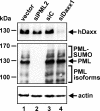Nuclear domain 10 components promyelocytic leukemia protein and hDaxx independently contribute to an intrinsic antiviral defense against human cytomegalovirus infection
- PMID: 17942542
- PMCID: PMC2224380
- DOI: 10.1128/JVI.01685-07
Nuclear domain 10 components promyelocytic leukemia protein and hDaxx independently contribute to an intrinsic antiviral defense against human cytomegalovirus infection
Abstract
Infection with DNA viruses commonly results in the association of viral genomes with a cellular subnuclear structure known as nuclear domain 10 (ND10). Recent studies demonstrated that individual ND10 components, like hDaxx or promyelocytic leukemia protein (PML), mediate an intrinsic immune response against human cytomegalovirus (HCMV) infection, strengthening the assumption that ND10 components are part of a cellular antiviral defense mechanism. In order to further define the role of hDaxx and PML for HCMV replication, we generated either primary human fibroblasts with a stable, individual knockdown of PML or hDaxx (PML-kd and hDaxx-kd, respectively) or cells exhibiting a double knockdown. Comparative analysis of HCMV replication in PML-kd or hDaxx-kd cells revealed that immediate-early (IE) gene expression increased to a similar extent, regardless of which ND10 constituent was depleted. Since a loss of PML, the defining component of ND10, results in a dispersal of the entire nuclear substructure, the increased replication efficacy of HCMV in PML-kd cells could be a consequence of the dissociation of the repressor protein hDaxx from its optimal subnuclear localization. However, experiments using three different recombinant HCMVs revealed a differential growth complementation in PML-kd versus hDaxx-kd cells, strongly arguing for an independent involvement in suppressing HCMV replication. Furthermore, infection experiments using double-knockdown cells devoid of both PML and hDaxx illustrated an additional enhancement in the replication efficacy of HCMV compared to the single-knockdown cells. Taken together, our data indicate that both proteins, PML and hDaxx, mediate an intrinsic immune response against HCMV infection by contributing independently to the silencing of HCMV IE gene expression.
Figures








References
-
- Adler, H., M. Messerle, and U. H. Koszinowski. 2003. Cloning of herpesviral genomes as bacterial artificial chromosomes. Rev. Med. Virol. 13111-121. - PubMed
-
- Ahn, J. H., E. J. Brignole, III, and G. S. Hayward. 1998. Disruption of PML subnuclear domains by the acidic IE1 protein of human cytomegalovirus is mediated through interaction with PML and may modulate a RING finger-dependent cryptic transactivator function of PML. Mol. Cell. Biol. 184899-4913. - PMC - PubMed
-
- Ahn, J. H., and G. S. Hayward. 2000. Disruption of PML-associated nuclear bodies by IE1 correlates with efficient early stages of viral gene expression and DNA replication in human cytomegalovirus infection. Virology 27439-55. - PubMed
-
- Andreoni, M., M. Faircloth, L. Vugler, and W. J. Britt. 1989. A rapid microneutralization assay for the measurement of neutralizing antibody reactive with human cytomegalovirus. J. Virol. Methods 23157-167. - PubMed
Publication types
MeSH terms
Substances
LinkOut - more resources
Full Text Sources
Medical
Molecular Biology Databases

